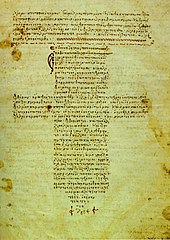
Al-Majusi is best known for his Kitāb Kāmil aṣ-Ṣināʿa aṭ-Ṭibbiyya (كتاب كامل الصناعة الطبية "Complete Book of the Medical Art"), later called The Complete Art of Medicine,[1] which he completed circa 980. He dedicated the work to the Emir, and it became known as the Kitāb al-Malakiyy (كتاب الملكي, "Royal Book", or in Latin Liber Regalis or Regalis Dispositio). The book is a more systematic and concise encyclopedia than Razi's Hawi, and more practical than Avicenna's The Canon of Medicine, by which it was superseded.[citation needed]
The Maliki is divided into 20 discourses, of which the first ten deal with theory and the second ten with the practice of medicine. Some examples of topics covered are dietetics and materia medica, a rudimentary conception of the capillary system, interesting clinical observations, and proof of the motions of the womb during parturition (for example, the child does not come out, but is pushed out).
In Europe a partial Latin translation was adapted as the Liber pantegni by Constantinus Africanus (c. 1087), which became a founding text of the Schola Medica Salernitana in Salerno. A complete and much better translation was made in 1127 by Stephen of Antioch, and this was printed in Venice in 1492 and 1523. Haly's book of medicine is cited in Chaucer's Canterbury Tales.
The work emphisized the need for a healthy relationship between doctors and patients, and the importance of medical ethics. It also provided details on a scientific methodology that is similar to modern biomedical research.
Neuroscience and psychology were discussed in The Complete Art of Medicine. He described the neuroanatomy, neurobiology and neurophysiology of the brain and first discussed various mental disorders, including sleeping sickness, memory loss, hypochondriasis, coma, hot and cold meningitis, vertigo epilepsy, love sickness, and hemiplegia. He placed more emphasis on preserving health through diet and natural healing than he did on medication or drugs, which he considered a last resort.
Ali ibn Abbas al-Majusi was a pioneer in psychophysiology and psychosomatic medicine. He described how the physiological and psychological aspects of a patient can have an effect on one another in his Complete Book of the Medical Art. He found a correlation between patients who were physically and mentally healthy and those who were physically and mentally unhealthy, and concluded that "joy and contentment can bring a better living status to many who would otherwise be sick and miserable due to unnecessary sadness, fear, worry and anxiety.
sumber dari: en.wikipedia.org
No comments:
Post a Comment